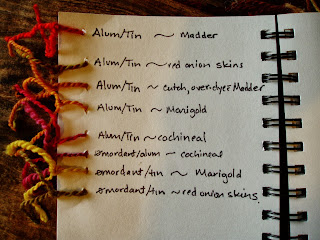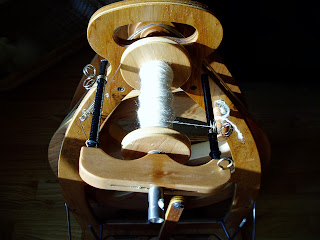Thursday, October 31, 2013
Oh the Horrors!
Striking fear in the heart of all spinners! A Man-Eating Sheep is roaming the neighborhood. Happy Halloween!
Sunday, October 20, 2013
Mixed Mordant Experiment
 Mordants are substances that dyers use to adhere dyes to fibers. Typically dyers use alum, copper, tin, tannic acid, or iron, among others. Each of the mordants will have a different effect on the color. A mordant can brighten, dull, or change a color all together. You can add the mordant to the fiber before, during, or after the dyeing process. My mixed mordant experiment goes like this: I would pre-mordant roving, then spin it into singles, then ply together singles that had different mordants. My prediction: if I dip a multi-mordant strand into the dye it should come out with two colors, giving it a barber-pole effect.
Mordants are substances that dyers use to adhere dyes to fibers. Typically dyers use alum, copper, tin, tannic acid, or iron, among others. Each of the mordants will have a different effect on the color. A mordant can brighten, dull, or change a color all together. You can add the mordant to the fiber before, during, or after the dyeing process. My mixed mordant experiment goes like this: I would pre-mordant roving, then spin it into singles, then ply together singles that had different mordants. My prediction: if I dip a multi-mordant strand into the dye it should come out with two colors, giving it a barber-pole effect. After I dissolved a teaspoon of tin in some water I let it cool completely. I added the wool and slowly heated the mordant bath until it was simmering. I let it simmer for half an hour and then let it all cool to room temperature. I carefully rinsed the roving. Essentially there was no sudden change in temperature or agitation of the wool to prevent felting.
Next I did the same procedure with an alum mordant. After all the roving was dry I spun singles then plied the different mordant strands together.
The results were mixed. Some of the color variations were too subtle to notices. Others had the barber-pole effect that I was looking for. The yarn that I'm holding above was made with a tin/alum combination yarn dyed with red onion skins.
This pink yarn was make with one strand of alum and one strand with no mordant plied together than dyed with cochineal.
In general I don't enjoy keeping records, but I did take notes this time. One thing that I learned during this experiment is that I really like what tin does to the natural dyes. The brightest colors came from the tin.
As soon as the little skeins were dry, I rolled them into balls and started a knitting project.
Friday, October 18, 2013
Mushroom Dye Class
The mushroom dye class put on by the Puget Sound Mycological Society was lots of fun. Our teacher was Alissa Allen and you can see her website here: Mycopigments.com We tore up a bunch of mushrooms and put them in a pot. Alissa told us about checking the ph to bring out the colors.
There was a display of mushroom and lichen dyed fibers and garments.
We each dyed 2 silk scarfs. This all took us only 2 hours and I was happy to leave prepared to go out on my own and try dyeing with mushrooms. I very much appreciated the handout Alissa gave us that will help my identify the most common mushrooms for dyeing. I'm going to try to get out this weekend for a hike and see if I can find some.
There was a display of mushroom and lichen dyed fibers and garments.
We each dyed 2 silk scarfs. This all took us only 2 hours and I was happy to leave prepared to go out on my own and try dyeing with mushrooms. I very much appreciated the handout Alissa gave us that will help my identify the most common mushrooms for dyeing. I'm going to try to get out this weekend for a hike and see if I can find some.
Monday, October 14, 2013
A Blank Canvas.
This weekend I spun up any wool in my stash that is white. This is all in preparation for dyeing, of course. Tonight I'll be attending a Mushroom Dyeing class. Earlier this fall I joined the Puget Sound Mycological Society with a plan to learn about mushrooms for eating and dyeing. I've been reading and watching youtube videos about mushroom identification. This weekend I attended the annual event that the Puget Sound Mycological Society puts on. There were TOO MANY people there when I went on Saturday so I had a hard time seeing all the displays. How wonderful that the problem was too much interest!
Now that I have some white yarn---my blank canvas---bring on the mushrooms!
Now that I have some white yarn---my blank canvas---bring on the mushrooms!
Tuesday, October 8, 2013
On and on and on...
Lace knitting has always been one of my favorite things to do. This one has been quite a challenge because it's boring in the middle. The middle part of this shawl has a 6 row repeat that needs to be done 30 time. It takes over an hour to do the 6 rows. I'm 15 repeats in to. Ugh. I think it will all be worth it because the pattern is lovely. It's a free knitty pattern called Anthemion. I started it LAST MAY and I'm half way done. This is hands down the longest knitting project I have ever done.
Saturday, October 5, 2013
Madder-Dyed Scarf
Thursday, October 3, 2013
Dyeing with Madder
From left to right:
1. handspun wool that was once dyed with cutch then over-dyed with madder with an alum mordant
2. hand carded, hand spun blended alpaca that I spun last month, dyed madder/alum
3. Norwegian White hand spun dyed with madder/alum
4. Norwegian White hand spun dyed with madder/iron
I've been dyeing.
These are the yarns that I'm using for a little weaving project. I'm warping the loom now.
Subscribe to:
Posts (Atom)

.JPG)
.JPG)
.JPG)














